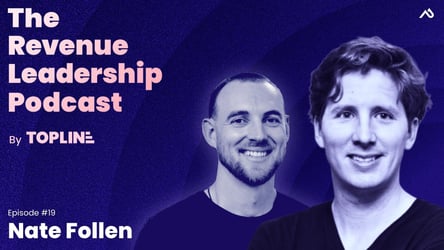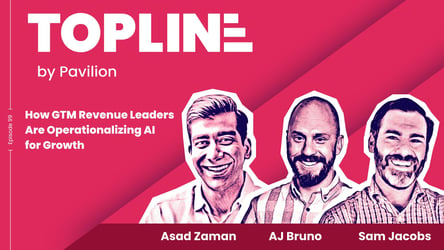


There's a growing anxiety among revenue leaders about AI adoption. The relentless pressure to "not get left behind" combined with an overwhelming array of tools and approaches has many questioning where to begin. After a deep conversation with Jordan Crawford, founder of Blueprint Go-To-Market and one of the sharpest minds in AI-enabled revenue generation, I want to share a framework for thinking about this transformation.
We're at an inflection point in go-to-market strategy. The old playbook of scaling outbound through "predictable revenue" motions is breaking down. Market saturation, reduced budgets, and evolving buyer expectations demand a more sophisticated approach. The companies winning today are building data-driven, AI-enabled revenue engines - but getting there requires fundamental changes to how we operate. And there’s nobody better to learn from than Jordan, in my humble opinion. He’s the person I turn to with my most important AI questions.
Start With Strategy, Not Technology
The most common mistake I see is trying to bolt AI onto existing processes without revisiting fundamental strategic questions. As Crawford notes, "People are trying to bolt AI into the previous system and we need to think about this as the moment for the go-to-market motion to have the same transformation that we did with engineering teams and product motions."
The key is starting with a clear understanding of your ideal customer profile (ICP) and ruthlessly focusing your efforts. This might mean dramatically narrowing your target market - Crawford shared an example of a company that went from a broad horizontal approach to focusing on just 2,000 target accounts. While this felt scary initially, it allowed them to build deep expertise and unique data advantages that drove their valuation from $10M to $200M.
The List is the Message
One of Jordan’s most powerful insights is that "the list is the message." Rather than trying to personalize generic outreach at scale, successful companies are building proprietary datasets that allow them to identify prospects with genuine needs and craft highly relevant messaging. If you can focus your outreach down to a very specific cross section of accounts that share close similarities then the message to reach these customers becomes obvious.
This approach requires building a robust data infrastructure to identify and analyze buying signals, creating workflows that translate data into actionable insights, and enabling your team to have genuinely valuable conversations. The goal isn't just better targeting - it's fundamentally changing how we understand and engage with our market. Jordan shares some interesting examples in the pod but you should check out his YouTube channel for way way more.
The New GTM Stack
To execute this strategy, revenue organizations need to develop new capabilities across three core areas. First, they need sophisticated data operations that can collect, enrich, and analyze customer data at scale. Second, they need AI infrastructure that can integrate with large language models, handle prompt engineering, and validate outputs. Finally, they need the human capital to make it all work - from data scientists to go-to-market engineers to AI-enabled sellers.
This is a new way of working and Jordan shares an approach to getting started.
Where to Begin
For most organizations, this transformation requires a 6-9 month commitment and dedicated resources. The journey typically starts with strategy - analyzing your customer base to identify your most successful segments and building conviction around a narrower focus. This strategic work must be followed by building the technical foundation, including implementing basic data collection and enrichment processes.
Only after these foundations are in place should organizations focus on enabling their teams. This includes training leaders on AI fundamentals, building literacy around data-driven decision making, and creating feedback loops for continuous improvement.
The Path Forward
This transformation won't be easy. It requires new skills, new tools, and fundamentally new ways of thinking about revenue generation. But the companies that get this right will build sustainable advantages that compound over time.
The future of revenue belongs to organizations that can build proprietary data advantages, deploy AI effectively across their stack, and enable their teams with next-generation tools and skills. Most importantly, it belongs to those who can execute with focus and discipline.
A Note on AI Literacy
While revenue leaders don't need to become technical experts, developing AI literacy is crucial for imagining possibilities and making strategic decisions. One practical approach is to replace Google with ChatGPT for learning and research. Creating dedicated chat threads for different domains like AI, health, and business strategy can help organize your learning journey. The voice mode feature is particularly useful for natural exploration of topics.
I push my leadership team on this almost weekly on this topic and consistently share anything interesting I’m reading or learning. A great place to start is this insane master class from Andrej Karpathy that I can’t believe is free.
The time to start is now. As Crawford notes, "Don't try to solve a pipeline problem. Try to solve a data problem. And before you solve a data problem, know what data you should ask for."
Want more content from Topline? Check out Topline podcast with Sam Jacobs, AJ Bruno, and Asad Za

As CRO for Owner.com, Kyle leads a team of world class go to market professionals who help independent restaurants grow their direct, online takeout and delivery channels. He currently owns the sales, partnerships, onboarding, success, support, revenue operations and enablement portfolios. Kyle leverages his 15+ years of experience in B2B SaaS sales, go-to-market strategy, and revenue leadership to provide value-added solutions for his clients and drive growth for his company.

